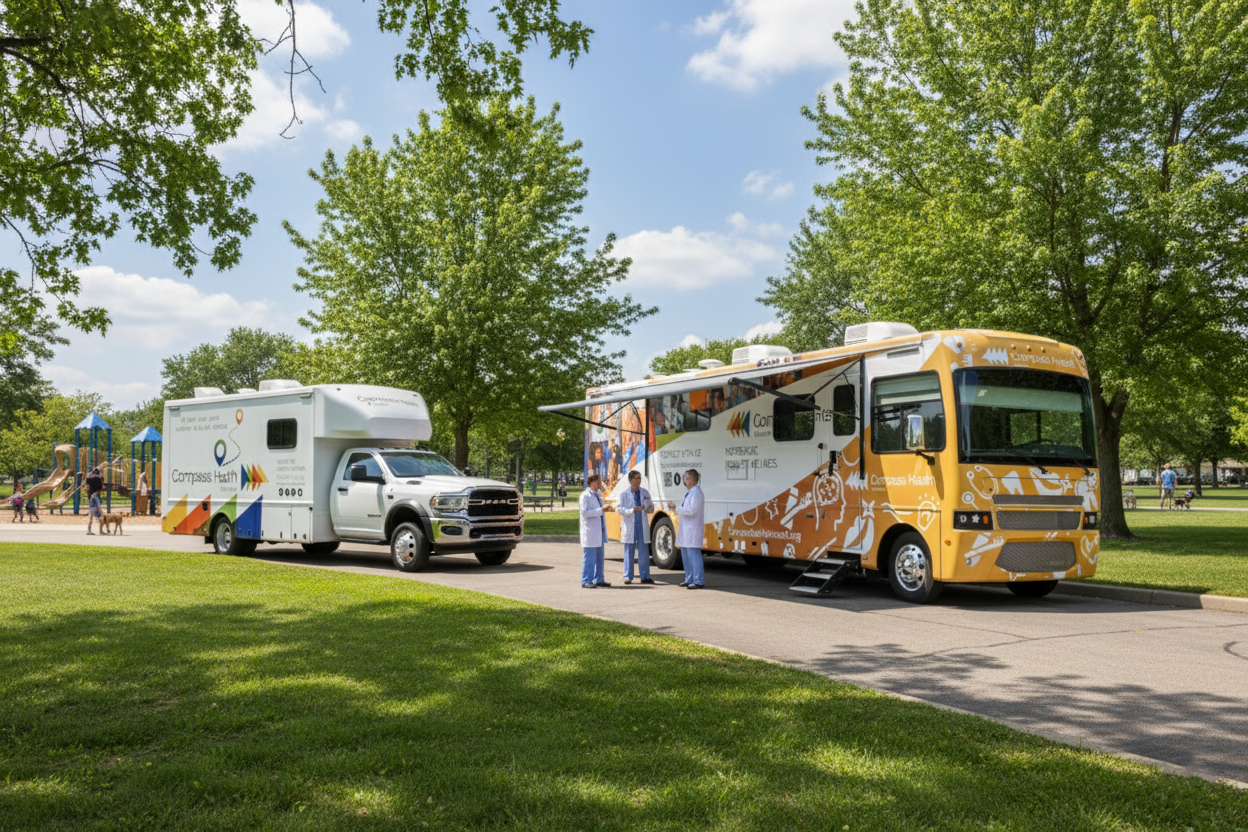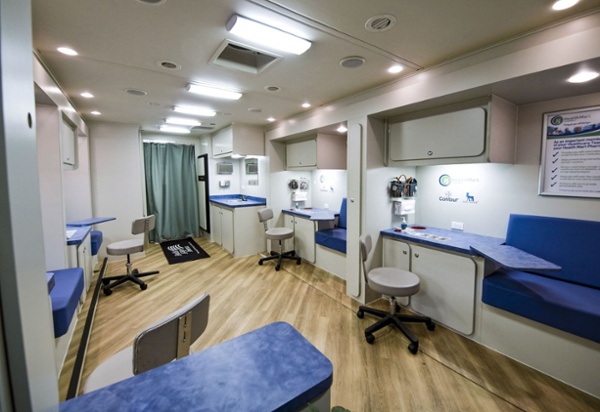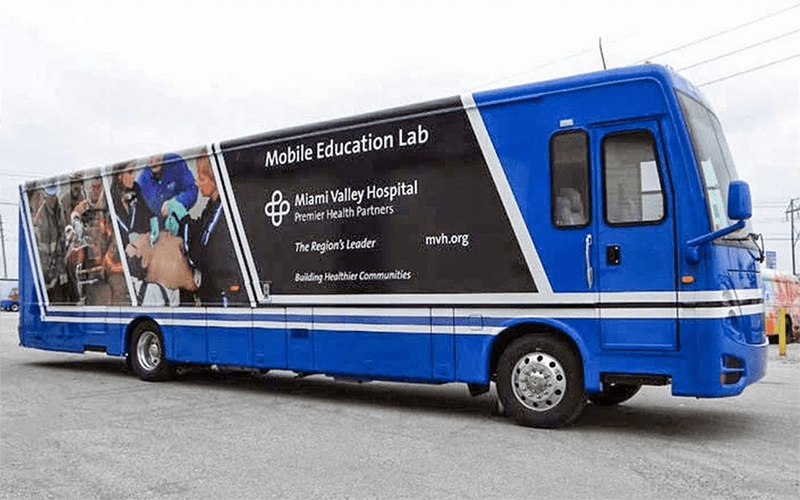How Medical Trailers are Helping Vaccinate America
The coronavirus pandemic has forced us to expand our vocabularies to include terms like social distancing, quarantine, contact tracing, asymptomatic,...
9 min read
Craftsmen Industries Oct 20, 2025 5:40:27 AM

Access to quality healthcare is not evenly distributed, and mobile medical solutions have stepped in to bridge the gap. A medical trailer is a large, towable unit designed to function like a full clinic, while a medical van is a smaller, self-contained vehicle often used for outreach or screenings. At first glance, they may seem similar, but their ability to deliver consistent, long-term care is very different.
The need for such mobile units is rising. According to the World Health Organization, nearly half of the global population lacks access to essential health services. In the United States alone, more than 61 million people live in rural areas where healthcare access is limited, leading to higher rates of preventable hospitalizations.
The global mobile clinic market was valued at about USD 2.3 billion in 2023 and is projected to nearly double to USD 4.5 billion by 2032. This rapid growth is fueled by the increasing demand for accessible healthcare services, particularly in remote and underserved communities where traditional care facilities are limited.
In this article, we’ll compare medical trailers and medical vans, breaking down their strengths and limitations. Most importantly, we’ll explain why trailers stand out as the more effective choice for sustainable healthcare delivery in today’s rapidly evolving medical landscape.
When discussing mobile healthcare, two of the most common vehicle types are medical trailers and ambulances, also known as medical vans. While both serve the purpose of bringing care closer to patients, they differ significantly in size, functionality, and long-term usability.
Medical Trailers are large, customizable units designed to function as long-term healthcare facilities on wheels. They can be built to include advanced medical equipment such as mammography machines, dental chairs, diagnostic labs, or even minor surgical suites.
Due to their size and modular design, trailers are frequently utilized for rural outreach programs, government health screenings, military healthcare support, and disaster relief efforts that require continuous services. Their scalability allows them to support multiple healthcare providers and offer comprehensive care under one roof.
Medical Vans, on the other hand, are smaller, more compact units primarily suited for short-term or highly mobile operations. They are typically equipped for basic screenings, vaccinations, or wellness checks rather than advanced diagnostics. Vans are most often used by nonprofits, local clinics, or community health programs that require rapid mobility but do not need extensive infrastructure. However, their limited space and capacity make them less suitable for extended healthcare delivery or advanced medical procedures.
In short, trailers offer long-term, scalable healthcare solutions, while vans prioritize quick, lightweight mobility for basic medical outreach.
Mobile healthcare solutions vary widely depending on the type of vehicle used. While both medical trailers and medical vans play a crucial role in expanding healthcare access, they differ significantly in terms of design, capacity, and long-term effectiveness.

Let’s discuss some points to have a better and clearer view,
Medical trailers are designed with multiple rooms and advanced infrastructure, enabling healthcare teams to deliver comprehensive services simultaneously. For example, a mobile mammography trailer can incorporate an imaging suite, control room, and patient changing area, all within a single unit.
Trailers can also support dental chairs, medical labs, or minor surgery setups, making them equivalent to small clinics. Vans, however, are constrained by their compact design and typically serve as short-term outreach vehicles for vaccinations, wellness checks, or basic screenings. This makes them effective for quick mobility but not ideal for multi-specialty or high-volume care delivery.
Meeting healthcare compliance standards is easier with medical trailers due to their size and modular build. Trailers can be equipped with ADA-compliant wheelchair ramps, infection control surfaces, HVAC redundancy for improved air quality, and ISO/AS9100-certified systems.
These features ensure patient and staff safety while adhering to international healthcare guidelines. Vans, by contrast, often struggle to accommodate these requirements due to space restrictions and design limitations, making them less suitable for long-term or large-scale healthcare projects that demand strict compliance.
Trailers are designed to replicate the feel of a traditional clinic, with private examination rooms, waiting spaces, and easy accessibility for patients with disabilities. This setup promotes patient dignity, privacy, and overall satisfaction. Vans, however, are much more cramped, often forcing staff to perform consultations in small, open spaces with little room for equipment or patient privacy.
For communities where trust and comfort are crucial, trailers offer a significantly superior patient experience compared to vans.
Medical trailers are a long-term investment in healthcare, built for durability and flexibility. They can be upgraded with new technology, reconfigured for different medical services, and used for decades with proper maintenance.
Vans, in contrast, are generally short-term solutions with limited customization options. While they work well for immediate outreach needs, their lifespan and adaptability fall short compared to trailers, which continue to deliver value over time.
Medical trailers offer a clear advantage over medical vans in terms of durability, functionality, and long-term healthcare delivery. While vans provide mobility and convenience, trailers are built for resilience and comprehensive care.
Here are the most significant advantages of medical trailers:
Medical trailers are designed for 15–20 years of service with proper maintenance, whereas vans typically last only 5–10 years. Their stronger chassis and ability to withstand heavy use make them better suited for demanding healthcare programs. During disaster relief operations, the Federal Emergency Management Agency has repeatedly deployed medical trailers because of their durability in crisis environments.
Unlike vans, medical trailers provide ample space and infrastructure to support advanced diagnostic and treatment equipment, including digital imaging systems, dental chairs, and on-site laboratories. For instance, mobile mammography units have proven highly effective in serving underserved communities.
Trailers more easily meet ADA accessibility standards, HVAC redundancy, infection control, and ISO requirements, which are challenging to implement in vans due to limited space. According to the U.S. Department of Health & Human Services, compliance with accessibility and safety standards is critical for healthcare delivery in federally funded programs, making trailers a better long-term solution.
Medical trailers can be configured into specialized units. This flexibility allows NGOs and hospitals to adapt trailers as healthcare needs evolve. For instance, Doctors Without Borders (MSF) has successfully deployed customized mobile clinics in conflict zones, highlighting the scalability of trailers for diverse missions.
Patients are more likely to trust care received in a clinic-like trailer with private consultation rooms, waiting areas, and professional layouts. Research published in the National Library of Medicine shows that patient satisfaction increases significantly when privacy and comfort are prioritized, a benefit that trailers provide more effectively than vans.
Although trailers require higher upfront investment, their longer lifespan, larger capacity, and ability to manage complex care make them more cost-effective over time. They reduce the need for multiple vehicles and function as full-service clinics on wheels, maximizing outreach and service delivery.
A report by Harvard Medical School’s Family Van and Mobile Health Map revealed a remarkable return on investment; mobile clinics delivered cost savings of up to $36 for every $1 invested, primarily by averting expensive emergency department visits.
So, medical trailers are more durable, better equipped, compliant with regulations, customizable, trusted by patients, and financially sustainable, making them a superior choice for long-term healthcare delivery compared to vans.

While medical trailers often emerge as the stronger long-term solution, medical vans still serve important roles in certain contexts. Vans are particularly effective for short-term outreach programs, such as mobile vaccination drives or health fairs, where speed and flexibility matter more than capacity.
Because they are smaller and more affordable to operate, vans are often chosen by low-budget NGOs or community-based organizations that primarily deliver basic screenings, such as blood pressure checks, glucose monitoring, or COVID-19 testing. For example, the CDC highlights the importance of mobile vaccination units during the COVID-19 pandemic in reaching underserved communities.
Their compact size also makes them well-suited for urban areas with dense traffic or narrow streets where maneuverability is critical. However, it is important to recognize their limitations. Vans typically have restricted space, making it difficult to maintain patient privacy, integrate specialized equipment, or comply with higher-level safety standards.
For hospitals, government agencies, or long-term healthcare projects that demand durability, compliance, and full-service capacity, medical trailers remain the preferred choice. As one study on mobile health strategies highlights, larger mobile units provide greater efficiency and patient trust in sustained healthcare delivery.
When deciding between medical trailers and vans, it's vital to consider not only the initial investment but also long-term efficiency, maintenance, and the cost per patient. Here's how they compare across key financial dimensions:
Medical vans are the more affordable option for organizations that need a quick entry into mobile healthcare. On average, they cost between $125,000 and $225,000, depending on the equipment and customization required.
By comparison, medical trailers require a much larger upfront investment, ranging from $250,000 to well over $1 million. This price reflects their larger size, ability to house multiple treatment rooms, and advanced compliance features.
Running either option involves significant ongoing expenses, including staffing, fuel, insurance, and maintenance of equipment. A study published in BMC Health Services Research reported that an Oregon-based van program had startup costs of approximately $275,000, with annual operating expenses of around $308,000, primarily attributed to staff and vehicle maintenance.
Larger trailers typically cost more to operate, but their higher capacity means they can see far more patients per deployment, which lowers the cost per patient encounter. In fact, a systematic review in SAGE Journals found that mobile clinics overall provide care at a fraction of the cost of stationary facilities, with per-patient expenses ranging from $65 to $529.
While vans last only 5–10 years, medical trailers are designed for 15–20 years of service with proper maintenance, which dramatically improves their return on investment. Over time, trailers reduce the need for multiple smaller vehicles, allow providers to run full-service clinics on wheels, and offer modular upgrades that extend their value.
Research from Harvard Medical School highlights that mobile health programs, particularly those with larger setups, such as trailers, generate an estimated $12 to $36 in healthcare savings for every $1 invested, primarily by preventing unnecessary emergency room visits.
Medical trailers play a crucial role in expanding healthcare access due to their flexibility, capacity, and durability. Below are key real-world applications showcasing their impact:
Mobile mammography trailers have proven highly effective at reaching populations with limited access to preventive healthcare. A retrospective study of a mobile mammography screening program operating over five years, which conducted 9,327 examinations, reported an early cancer detection rate of 1.5 per 1,000 examinations. The study states that the majority of detected cancers are small and low-stage. This clearly underscores the impact of bringing diagnostic services directly to communities
In response to the COVID-19 pandemic, specialized mobile laboratories, often built within trailers, were deployed to offer critical testing capabilities. The Athena Mobile Laboratory enabled rapid COVID-19 testing in military and rural settings, featuring onboard diagnostic instruments, biosafety environments, and scalable HVAC systems for safe and efficient operations.

Trailers transform into swift, mobile field hospitals during emergencies. The MED-1 mobile hospital, deployed after Hurricane Katrina, delivered ICU-level care, effectively reducing strain on local emergency departments. These units combine portability with full critical care setups, demonstrating high resilience in disaster zones.
Military trailers, such as modular field hospitals, have been deployed in both humanitarian and combat scenarios for a long time. The U.S. military’s Expeditionary Medical Support System (EMEDS) exemplifies this, providing scalable medical facilities that offer primary care, surgery, and dental services for operations such as the Ebola epidemic response in West Africa.
Yes, medical trailers generally cost more upfront, ranging from $250,000 to over $1 million, depending on their size and level of customization. In contrast, medical vans typically cost between $125,000 and $225,000. However, trailers are designed for 15–20 years of service with proper maintenance, compared to 5–10 years for vans. This longer lifespan, plus their ability to handle full clinical setups, makes trailers more cost-effective over time.
Medical trailers, equipped with multiple exam rooms and waiting areas, can serve dozens of patients daily, sometimes exceeding 50–75 visits per day, depending on the program. In contrast, vans, due to their limited space, typically serve 5–15 patients a day, primarily for basic screenings or consultations.
Yes, trailers more easily meet requirements such as ADA accessibility, infection control protocols, HVAC redundancy, and even ISO/AS9100 standards for specialized medical builds. Vans, because of their smaller footprint, often struggle to integrate these systems without significant compromise.
Vans can be deployed almost immediately since they operate like standard vehicles, ideal for short-term outreach or screenings. Trailers require towing and setup, which can take several hours to a full day, but once operational, they provide a stable, long-term medical base that far surpasses a van in capacity.
Hospitals and NGOs often choose trailers because they deliver better return on investment (ROI), stronger patient trust, and full compliance with healthcare standards. Trailers can be fully customized with imaging, dental, or laboratory equipment, essentially functioning as mobile clinics. NGOs and agencies, such as FEMA, also prefer trailers for disaster relief due to their durability and scalability in crisis environments.
Mobile healthcare solutions play a crucial role in bridging gaps in access, particularly for rural and underserved populations. While medical vans provide a quick and budget-friendly way to conduct small-scale outreach or basic screenings, their limited space and shorter lifespan make them less effective for long-term healthcare delivery.
In contrast, medical trailers offer scalability, advanced equipment integration, and compliance with industry standards, making them the more reliable and sustainable option for hospitals, NGOs, and disaster relief programs seeking to maximize patient impact.
For organizations ready to invest in high-quality, long-lasting mobile healthcare infrastructure, partnering with an experienced provider is essential. Craftsmen Industries is a trusted leader in designing and manufacturing state-of-the-art medical trailers tailored to meet diverse healthcare needs. Their expertise ensures that every unit is compliant, durable, and optimized for patient comfort.
If your goal is to deliver scalable, world-class mobile healthcare, Craftsmen Industries provides the solutions you need to get there.

The coronavirus pandemic has forced us to expand our vocabularies to include terms like social distancing, quarantine, contact tracing, asymptomatic,...

Traditional healthcare within the United States consists of a network of providers located in clinics, hospitals, and offices. For many insured...

As a nation, we have become weary of the coronavirus pandemic. We are ready for it to disappear and for life to return to normal. Unfortunately, if...